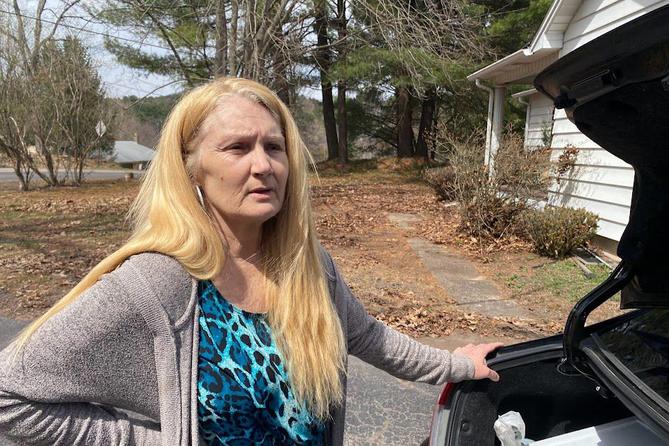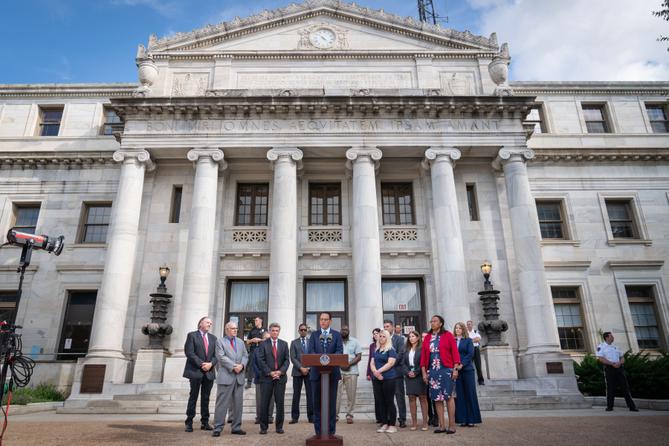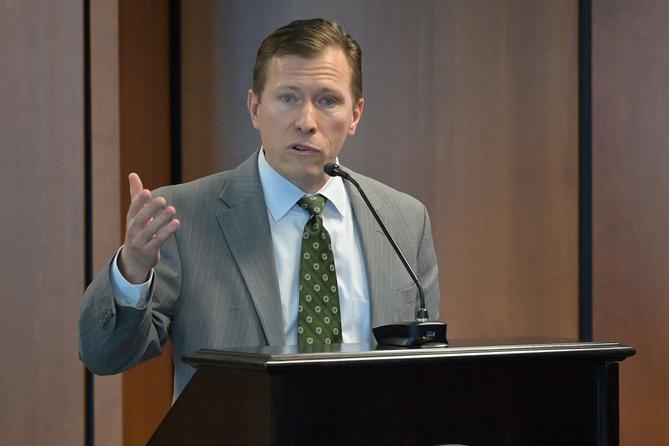Spotlight PA is an independent, nonpartisan newsroom powered by The Philadelphia Inquirer in partnership with PennLive/The Patriot-News, TribLIVE/Pittsburgh Tribune-Review, and WITF Public Media. Sign up for our free newsletters.
HARRISBURG — A historic settlement to resolve claims against opioid companies is expected to bring Pennsylvania more than $1 billion, but clashes over how to spend and oversee the money exemplify the divides in responding to an epidemic that kills thousands of residents a year.
Democratic Gov. Josh Shapiro has described the funding as “earmarked to offer and expand life-saving treatment options.” But the potential uses extend beyond medical treatment, and local leaders say they want to tailor the relief to their needs.
Some funding has already arrived, and these early conversations could shape how money from other opioid cases is spent. A second wave of settlements could bring more than a half a billion dollars more to the state, according to a recent public presentation from the state attorney general’s office. And that estimate didn’t include all opioid cases.
In Pennsylvania, county government officials will control most of the funds — and some want to spend it on law enforcement, which has created an early point of contention and confusion.
A working group in Lancaster County suggested spending $275,000 a year from opioid settlement money for its drug task force, with the goal of “Preventing Drug Dealers from preying on our community.”
A commissioner in Butler County received a request from police to spend money on a device — which the commissioner said was estimated to cost about $100,000 — that can quickly identify drugs.
Luzerne County District Attorney Sam Sanguedolce suggested spending settlement money on two deputy coroners to respond to opioid overdose deaths, noting that investigations of those deaths could lead to criminal charges against whoever provided the drugs. Sanguedolce also proposed spending money on two detectives for opioid investigations — along with guns, vests, and vehicles for them.
“That burden shouldn’t fall on the taxpayers out of our general budget,” Sanguedolce told Spotlight PA and WESA. “And, quite frankly, we don’t have spare money to throw around to increase the number of law enforcement officers out there.”
It’s unknown how many counties are considering spending opioid settlement money on law enforcement. There’s no one resource that tracks how counties are spending their money, and some are still in the early stages of deciding. The possible uses are broad. Settlement documents list a range of approved treatment services, education initiatives, and prevention programs, such as outreach to medical providers about best prescribing practices for opioids.
In Pennsylvania, a 13-member oversight board is responsible for ensuring counties and local governments spend money appropriately. In February, it provided guidance — which Spotlight PA and WESA obtained through open records requests — on the law enforcement issue. But questions remain about how much discretion counties ultimately will have, and how transparent the decision-making process will be both for counties and the oversight trust.
A range of harm reduction and public health advocates said in interviews they’re concerned that law enforcement spending could crowd out other priorities — such as the overdose-reversal drug naloxone, syringe service programs, and medications for opioid use disorder — that research has shown can reduce overdose deaths or lessen other risks.
“I think it’s pretty clear in the history of drug policy here that … more focus on enforcement, more focus on incarceration, and more focus on coercion has never helped the situation under any circumstance,” said Alejandro Alves, who works on overdose prevention issues for the international public health nonprofit Vital Strategies.
In Luzerne County, Pam Keefe doesn’t want opioid settlement money to pay for more police officers to make more arrests. Her 22-year-old daughter Michalene Dougherty died from a drug overdose in 2018. Now, Keefe advocates for treatment and hands out overdose reversal medication and other supplies in hopes of reducing harm to people who use drugs.
“They need to spend it on harm reduction, and they need to spend it on people not dying,” she told Spotlight PA and WESA. “They need to get people into treatment and get them into housing and things like that, but not jail — definitely not jail.”

Shapiro has continued to focus on treatment. Days after taking office as governor, he appeared on Fox News and said a strong law enforcement response is needed but the state can’t arrest its way out of the crisis.
“It’s one of the reasons why as attorney general, I took on the pharmaceutical companies and won and brought over a billion dollars back to Pennsylvania specifically earmarked for treatment,” he said.
In response to questions from Spotlight PA and WESA, Shapiro spokesperson Manuel Bonder said money to counties and local governments will empower them “to help those struggling with addiction — with clear, legally binding guidance on permissible uses and strategies for the deployment of settlement funds.”
“As we continue working to support law enforcement and make Pennsylvania communities safer, it is the Governor’s strong belief that this settlement funding is to be used for treatment, prevention, and the core strategies that will help the families and communities that have suffered the consequences of this crisis,” Bonder added in the statement.
Who controls the spending?
In January 2022, then-Attorney General Shapiro’s office announced that all 67 counties had joined a national $26 billion opioid agreement with Johnson & Johnson and three major pharmaceutical distributors — Cardinal Health, McKesson, and AmerisourceBergen — over their “role in creating and fueling the nationwide opioid crisis.” The companies did not admit wrongdoing, and the money will be paid out over 18 years.
His statement called the agreement “the most significant influx of resources to our Commonwealth to address this epidemic, jet-fueled by greedy pharmaceutical companies.”

Each participating state is taking its own approach to distributing the funds.
In Pennsylvania, 70% goes to counties, based on a formula that guarantees a minimum of $1 million for each. Another 15% of funding goes to local governments that initiated their own litigation against companies, a category that also includes some counties. The remaining 15% goes to state lawmakers to control.
County commissioners, such as Kevin Boozel in Butler County, said they are acutely aware of the toll opioids have taken on their communities.
“People died because of what happened,” Boozel said. “And so while you can’t bring them back with this money, maybe you can keep some from ending up like the ones prior to them. That’s the whole goal of this.”
For several years, Pennsylvania has had one of the country’s highest drug overdose death rates. In 2021, Pennsylvania had 5,350 fatal drug overdoses, and 78% of them involved fentanyl, state data show.
In July 2022, a court order established a trust that will oversee how counties and local governments spend their money from the Johnson & Johnson and drug distributors agreements. The order also said the trust will manage money from similar future opioid settlements.
In late March, the chair of the oversight trust said at a public meeting the state had received about $130 million from the settlement with the three distributors and Johnson & Johnson, and that the majority of that money had been sent to counties.
Settlement documents say the money is intended for opioid remediation, which is broadly defined. The documents identify many priorities and approved uses. The list — known as Exhibit E — includes opioid overdose reversal drugs, medication-assisted treatment for opioid use disorder, recovery support, media campaigns to prevent opioid misuse, research, and regional planning.
The documents describe the list as “non-exhaustive,” and Exhibit E several times notes that funding isn’t limited to what it specifically describes.
The court order establishing Pennsylvania’s opioid trust says spending must be “consistent with the requirements of Exhibit E.” Brett Hambright, a spokesperson for the attorney general’s office, told Spotlight PA and WESA in an email that for “uses not within Exhibit E, the subdivision must ask the trust.” If the trust determines counties and local governments spent money inappropriately, and they don’t fix the problem, the trust can cut their funding.
How much discretion counties end up having is an open question.
“I think it really comes down to how those decision makers decide to wield their power,” said Tricia Christensen, director of policy for the Community Education Group, which has been tracking local spending plans.
Law enforcement guidance and questions
Counties have taken various approaches to deciding how to spend their money, who to involve in that process, and how to communicate such discussions with the public. Counties were supposed to file an annual report with the oversight trust by March 15 to show how they spent settlement money. But the trust waived that requirement for this year, according to records obtained by the newsrooms. In a March 1 email, an official with the attorney general’s office explained the decision, writing that “it is unlikely any significant expenditures have taken place.”
Meanwhile, the trust has operated mainly out of the public view, to the frustration of some harm reduction and treatment advocates. A court order in July 2022 established the responsibilities for the trust. But members didn’t hold their first public meeting until late March.
However, records obtained by Spotlight PA and WESA show the trust was active before the first public meaning. In February, it provided an FAQ to counties that clarified issues such as whether counties can use opioid settlement money for “law enforcement efforts to stop opioids from flooding into our communities.”
In its reply, the trust wrote that if recipients want to spend opioid funds on enforcement, “they can seek authorization from the Trustees and ultimately Commonwealth Court, and if approved may use funds for that purpose.” The guidance stated that drug enforcement efforts were “not explicitly authorized” in Exhibit E.
Exhibit E specifies some expenses related to law enforcement, such as criminal justice diversion programs and education to law enforcement about opioid-related treatment.
Tom VanKirk, the former chief legal officer for Highmark Health and chair of the trust, said the details of the plans matter. He said he wouldn’t expect the trust to approve spending “to beef up their police departments and add more people, which might be being added for a number of different reasons.”
If county officials ask for permission to spend money on law enforcement, and the trust denies it, they can appeal to Commonwealth Court, VanKirk said.
Lancaster County Commissioner Josh Parsons told Spotlight PA and WESA the law enforcement issue has “been a little bit confusing.”
In Lancaster County, Parsons led the working group that suggested in a written proposal to spend $275,000 out of an estimated $900,000 per year from a first allotment of opioid settlement money for “Preventing Drug Dealers from preying on our community.” He said county officials initially believed opioid settlement money could be used for law enforcement if it was specifically directed at “reducing illegal drug supply.”

The group also suggested using money for several other initiatives, including education efforts for schoolchildren, a criminal justice diversion program, and medication-assisted treatment for people in county jail, as well as prevention and support services for infants exposed to addictive substances in the womb.
Parsons said commissioners have not yet approved opioid settlement money for the drug task force. He still believes law enforcement spending should be allowed.
“If you want a holistic approach … you can’t just deal with treatment, and prevention, and recovery,” Parsons said. “You have to also prevent illegal drugs from coming into the community.”
Luzerne County’s district attorney made a similar argument.
Sanguedolce made his budget proposals in November. In March, he told Spotlight PA and WESA he hoped the county would soon approve them. Later, when asked about the trust’s law enforcement guidance and its potential impact on funding opioid detectives, he said in an email that “out of an abundance of caution, we would seek pre-approval prior to such use.”
Public documents show the head of Luzerne County’s human services division in December recommended creating a committee and “a formal process to determine how the opioid funds will be distributed.” The list of top priorities from Luzerne County county’s drug and alcohol department did not include drug enforcement efforts.
Tim McGinley, a Luzerne County Council member, told the newsrooms that the council hasn’t approved spending opioid settlement money yet.
“Everything’s pretty much up in the air,” McGinley said.
In Butler County, commissioners in February approved a resolution describing how they planned to spend about $977,000 in opioid settlement money. The list included medication-assisted treatment for people in the county jail, housing programs, community prevention, and recovery programs.
Boozel told Spotlight PA and WESA that he also received a request from law enforcement to spend opioid settlement money on a spectrometer, a high-tech device that can quickly identify types of drugs, such as fentanyl.
Boozel, who’s also on the oversight trust, said he planned to turn to his fellow board members for guidance.
“I can’t authorize it yet,” he said in an interview on March 23. “I’m gonna run it through the trust board and not vote on it.”
Boozel took the question to his fellow trust members the next week, VanKirk told the newsrooms.
An advisory committee of the trust “gave him guidance that that is permissible,” VanKirk said. But that discussion wasn’t public.
“Why should it be?” VanKirk said when questioned by Spotlight PA and WESA. “We cannot do in public every single discussion that we have. … The public has a right to know how it was spent, not necessarily what all the discussions were about the pros and the cons.”
In late March, VanKirk said the trust was working on a more formal process that would allow people to submit questions through the trust website, and “we will answer it in writing so it is available to all of the payees.” Boozel later told the newsrooms he planned to resubmit the question to the website “so it can be cataloged and formally answered in that system.” He declined to provide documents describing the proposal, saying they should be available online when “it is introduced formally.”
As of April 12, the newly launched trust website included a section to submit questions but its FAQ didn’t include any specific answers about law enforcement.
For now, many harm reduction and treatment advocates are waiting to see how that money will be spent — and are looking for ways to influence those decisions.
“People shouldn’t have to be fighting to get information,” said Jordan Scott, regional field organizer for the Pennsylvania Harm Reduction Network. “… When you allow that transparency, that’s also how you foster trust with community members.”
WHILE YOU’RE HERE… If you learned something from this story, pay it forward and become a member of Spotlight PA so someone else can in the future at spotlightpa.org/donate. Spotlight PA is funded by foundations and readers like you who are committed to accountability journalism that gets results.
